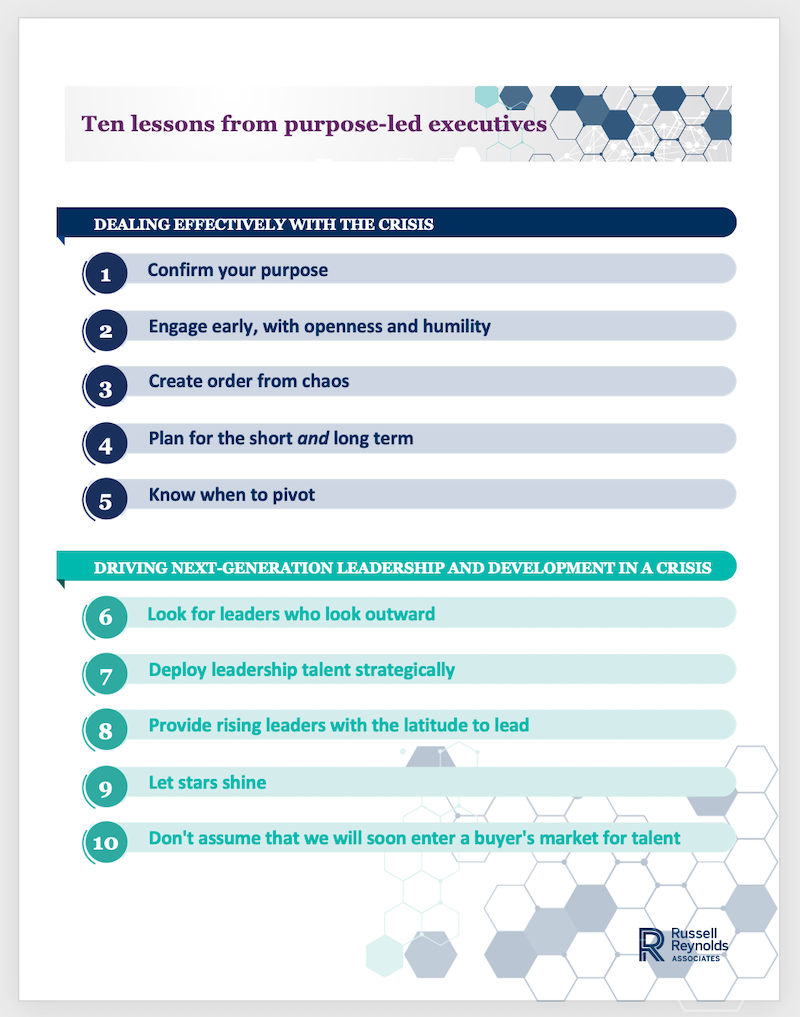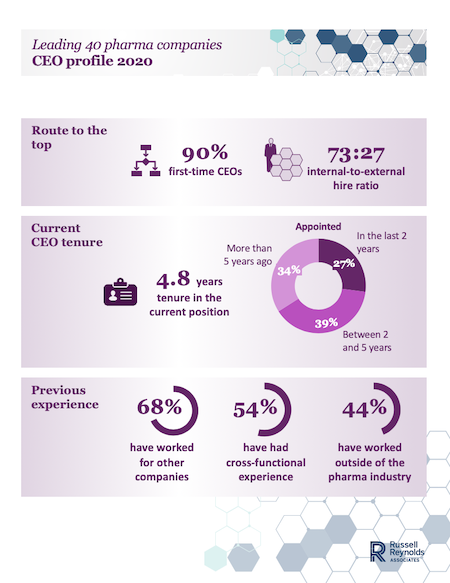The New Era of Purpose-Led Leadership in Pharma
Across all pharma companies' activities, the COVID-19 crisis has reinforced the need for pharma leaders to commit to, communicate, and exemplify the purpose that is at the center of their strategies and organizations.
The current COVID-19 pandemic is a global tragedy with profound human and economic consequences. While it has left leaders in many industries fighting to save their businesses, leaders in the healthcare ecosystem face a different challenge: They are fighting to save the world.
Dana M. Krueger

In every corner of the industry, healthcare companies are the best – and often the only – organizations equipped to directly address and end the pandemic. Across the healthcare ecosystem, different players are battling on multiple fronts to help solve the crisis. This includes diagnostics of coronavirus and antibodies, supply of ventilators and face shields, provision of remote monitoring tools, through to the treatment of patients in ambulatory and hospital settings – along with drug companies playing their primary role in driving the search for effective vaccines, treatments and cures.
Across all the activities of pharma companies – from their investments in product development to directly impact patients in need, to the research and supply alliances they are building, to the charitable donations they make – the COVID-19 crisis has reinforced the need for pharma leaders to commit to, communicate, and exemplify the purpose that is at the center of their strategies and organizations.
Pharma companies’ response: Purpose as a central driver
Saule Serikova

These days, we often ask our clients how they are feeling. Understandingly, many use words like anxious, challenged, concerned and stressed. At the same time, many in influential senior leadership roles describe their current mental status as energized, engaged, focused and reflective. This dichotomy demonstrates that the crisis can severely test – and reveal – the quality of an organization’s leadership. It is during these times that great leaders act – and act decisively, and with purpose. Through their actions, they set an example for everyone in the organization. They stand as the difference between thriving in a crisis or suffering irreparable damage.
To succeed in this moment, we recommend looking to the 10 lessons we’ve learned from purpose-led executives over the past years to help the companies emerge stronger in the moments of severe uncertainty. The first five focus on dealing with the crisis itself, the second five underscore the need to treat the crisis as a crucial training period for the next generation of leaders.
Dealing effectively with the crisis
1.
Click to enlarge

Confirm your purpose
Pharma has always existed to help patients; it now has the potential to contribute to leading us out of a global health and economic crisis. This is the right time to confirm each enterprise’s purpose and remind every team member of not only the “what” but also the “why” of the business. Tactical steps are essential, but purpose-driven leaders also think strategically about opportunities to build the positive momentum and secure followership.
2. Engage early, with openness and humility
Even when under pressure, purpose-led leaders engage earnestly with those around them to marshal the energy of the broader workforce. They create a sense of togetherness by having the humility to ask questions and listen to a wide range of opinions – not just those from their leadership team. They do not attempt to serve as the universal source of answers.
3. Create order from chaos
In the early days of a crisis, great leaders cut through the clutter of conflicting data and opinions, identifying the areas that need attention and allocating resources accordingly. They quickly develop and communicate a point of view on the best path forward, providing a welcome sense of direction
to an organization that might otherwise be paralyzed by indecision.
4. Plan for the short and long term
Purpose-driven leaders have the ability to devote the appropriate resources to the immediate needs of the organization while maintaining a focus on long-term strategic goals. These leaders don’t hesitate to make the hard choices to address short-term priorities; they also demonstrate the courage to preserve the investments that are essential to the long-term health of the organization. In the face of crisis, weak leaders are guided primarily by concerns over the “optics” of their decisions; strong, purpose-driven leaders are guided by a clear view of the sacrifices required to preserve purpose and strategic direction.
5. Know when to pivot
Great leaders are unsentimental about the strategies and tactics that have led to their success. Driven by purpose, they know that in some circumstances, trying something new is riskier than sticking with the playbook, but that pivoting to a different approach is the right decision. This ability to choose the right time to change tack instills confidence in the organization and injects the energy needed to drive change.
Drivng next-generation leadership and development in a crisis
In the current COVID-19 situation, we are seeing countless examples of extraordinary human performance and growth, as individuals and leaders come together to do what they can to help those around them, and society at large. Purpose-driven leaders not only focus on the immediate implications of this crisis, they are also looking to accelerate the growth and development of their rising leadership talent at all levels of the organization.
6. Look for leaders who look outward
During times of uncertainty, many top leaders succumb to the natural human tendency to retreat inward and fail to support each other. Ironically, they become more individualistic at the very time when leadership matters most. Purpose-led leaders recognize and resist this response, and, critically, support peers who need their guidance and mentorship.
7. Deploy leadership talent strategically
A crisis provides a critical moment to test and develop leaders. Great leaders are already assigning executives to rapid-response teams and forming new initiatives to confront the crisis. As they do so, they work to ensure that, where possible, critical initiatives are led not only by safe hands, but also by those with high potential. Established executives should be surrounded by those who will both make significant contributions and flex new leadership muscles.
8. Provide rising leaders with the latitude to lead
During a crisis, senior executives have a natural tendency to assert control, stripping away leadership responsibility from their direct reports in an effort to mitigate risk. As a result, rising executives become operators and executors, not leaders and decision-makers. In such a scenario, the team’s leadership skills will atrophy, and those weaknesses will echo through the leadership ranks for years afterwards.
9. Let stars shine
Great leaders ensure that senior leaders do not unwittingly allow hierarchy to stifle the emergence of the purpose-driven leaders with the best ideas. Merit and potential will reveal itself during a crisis, and the strongest leadership will often come from those without leadership titles. Great leaders do not stand in the way of the stars that emerge.
10. Don’t assume that we will soon enter a buyer’s market for talent
Though it may be counterintuitive, external hiring for top talent is about to get much harder. In environments characterized by extreme uncertainty, those in stable roles often become highly risk averse and unwilling to make a transition, even when unsatisfied with their current situation. Many forecasters believe that we are heading toward a buyer’s market for talent. We are not. This underscores, again, the need to develop your best talent.
Pharma score card: Opportunities for extraordinary performance ahead
Adapting corporate purpose to the needs presented by COVID-19 is critical right now and will be even more critical after the crisis has passed. In general, from an operational perspective, pharma is already beginning this adaptation process. Most pharma companies have pivoted their strategic course to bring an ‘all-hands-on-deck’ approach to finding crisis solutions. And pharma leaders have been among the first to look beyond their normal time horizons and outside their company walls to solve the crisis and help the global community.
Yet, as in every organization, there is still work to be done. Pharma leaders need to invest effort and time in building strong teams and developing next-generation leaders. During the crisis, new skill sets around teamwork, agility and risk-taking are being developed and tested. It is time to recognize the purpose-led executives in the broader ranks that will bring the organization thought the crisis – and support them with guidance and mentorship. And even when leaders need to make difficult decisions on investments in leadership and talent development, they should approach any reprioritization of their talent investments as thoughtfully as they do investments in top-line growth initiatives.
It is time to seize opportunities presented by emerging innovative operating models and new ways of employee engagement and collaboration with external stakeholders. A looming question is: Does the pharma industry have the right group of leaders in place to take full advantage of these opportunities?

Russell Reynolds Associates’ recent analysis of the CEOs of the top 40 global pharma companies offers some encouraging observations. Looking at the group as a whole, 90 percent of leading pharma companies are led by first-time CEOs who have held their positions, on average, for 4.8 years. Unlike their predecessors, many of these CEOs bring experiences across several functional areas, and from different parts of the healthcare ecosystem and beyond. This cross-training suggests we have a strong cohort of agile leaders who are familiar with thinking creatively and working collaboratively. By leveraging purpose as a behavioral compass, these leaders are able to not only navigate through the crisis, but transform their organizations and the pharma industry overall.
Outlook: Leadership redefined
In the coming months and years, we will undoubtedly see lasting changes in how we conduct business emerge from the current COVID-19 crisis. Among those we already see are the acceleration of digitalization, the virtualization of clinical trials and an evolution in how we work together. These operational changes may embed faster than expected, but pharma is overall well-positioned to adapt at pace.
Equally important are the lasting talent implications, which current pharma leaders should not overlook or delay in addressing. With the right encouragement and support now, strong leaders will come out of the current COVID-19 crisis – leaders who saw beyond short-term milestones and quarterly results and focused on the fundamental purpose that their organization could serve in the world. Over time, these purpose-led leaders will push the boundaries of their organizations and the pharma industry far past current limits, creating a higher impact and more resilient industry in the future.
Dana M. Krueger, PhD, is Global Healthcare Sector Leader, and Saule Serikova is Global Knowledge Leader for Healthcare, both at Russell Reynolds Associates.
The Misinformation Maze: Navigating Public Health in the Digital Age
March 11th 2025Jennifer Butler, chief commercial officer of Pleio, discusses misinformation's threat to public health, where patients are turning for trustworthy health information, the industry's pivot to peer-to-patient strategies to educate patients, and more.
Navigating Distrust: Pharma in the Age of Social Media
February 18th 2025Ian Baer, Founder and CEO of Sooth, discusses how the growing distrust in social media will impact industry marketing strategies and the relationships between pharmaceutical companies and the patients they aim to serve. He also explains dark social, how to combat misinformation, closing the trust gap, and more.